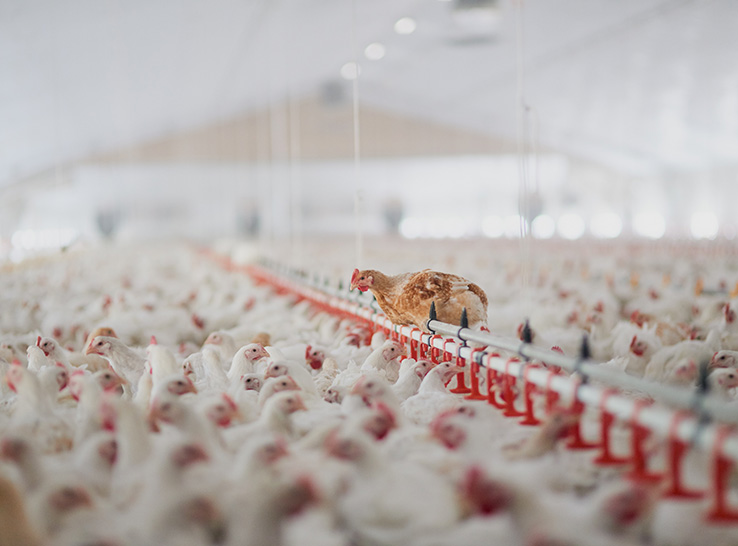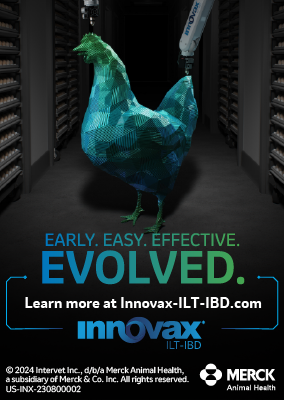Second in a series
 While most chicks are vaccinated for coccidiosis at the hatchery, it’s the first few weeks in the grower barn that determine coccidia exposure, cycling and eventual immunity. Managing the birds’ environment is key to a successful coccidiosis vaccination program.
While most chicks are vaccinated for coccidiosis at the hatchery, it’s the first few weeks in the grower barn that determine coccidia exposure, cycling and eventual immunity. Managing the birds’ environment is key to a successful coccidiosis vaccination program.
“We are technically vaccinating the chicken, but the goal is to vaccinate the house,” says Charlie Broussard, DVM, Merck Animal Health. “We use the chicken as the generator; give them a little dose of coccidia through the vaccine and then let the flock produce more coccidia oocysts to build immunity.”
It’s a balancing act to create the right environment for the growing chick and the evolving coccidia organisms. The process begins with prepping the barn before the birds arrive, allowing some downtime between flocks, amending the litter, getting the temperature and relative humidity right, and ensuring enough feed and water access.
“Brooder management, ensuring the chicks are warm, comfortable and eating, is critical to making the vaccines work,” Broussard adds.
There are universal brooder-management steps, but some decisions are influenced by whether the barn is raising small (4 pounds) or large birds (9 pounds).
Stocking density and housing considerations
The initial stocking density of a barn plays a critical role in the subsequent cycling of sporulated oocysts driven by the vaccine.
High-density housing places birds in a more compact space to ensure they access sporulated oocysts and effectively manage the second cycle. It is most applicable with small birds because they have a shorter exposure time (30 to 32 days) than large birds that can take 7 to 9 weeks to reach market weight.
Partial-house brooding is the method used to tighten the density of small birds, which is accomplished by using a floor-to-ceiling curtain to divide the barn in half. Only the inhabited part of the house is heated. However, if litter moisture becomes excessive or feeder space is limited, brooder space may need to be expanded earlier than the typical 10- to 14-day turnout to the full house, even during cool seasons, Broussard notes.
Low-density, full-house brooding can be successful, especially in warm seasons, but should be limited to large-bird programs because they have more time to reach full coccidial immunity. However, full-house brooding can be used with small-bird programs that have adequate downtime (2 weeks) between flocks to let the oocyst population subside before restocking.
Full-house brooding involves using migration fencing to evenly distribute birds within the pens and maintain a consistent temperature throughout the barn. This option is only recommended on reused litter.
During the second and third in-house oocyst cycles, brooding space of low-density flocks (big birds) may require adjustments to increase coccidiosis vaccine exposure. This can be accomplished by holding birds in the partial house area slightly longer to ensure good re-exposure to the coccidiosis vaccine before releasing birds into the full house.
Additionally, a controlled-release program, in which the curtains or migration fencing are raised and the birds are allowed to move to the non-brood area sooner, minimizes the stress of turnout on the birds and ensures uniform vaccine re-exposure for proper oocyst cycling. Controlled-release also helps correct wet litter conditions associated with partial-house brooding when low ventilation practices are employed in the winter months.
Bedding and litter drive the outcome
To ensure proper vaccinal-oocyst cycling in broilers, much hinges on bedding and litter management. “Bedding material needs to be fluffy, absorbent and comfortable for the chick,” Broussard says.
Pine shavings are most common, but depending on the region or availability, rice or peanut hulls are options as well. Do not use hardwood shavings as Aspergillus fumigatus often contaminates these products.
Regardless of the bedding material, a 4- to 6-inch base of good quality, built-up litter provides the best means of managing moisture and heat within the poultry house environment. Litter moisture helps maintain beneficial bacterial flora and generate heat. It’s also an indicator of relative humidity, which is needed to keep fecal droppings moist long enough to initiate the oocyst-sporulation process.
The ball test is a good indicator (Figure 1). The litter moisture-content target is 25%, at which a handful of litter can be formed into a ball temporarily before falling apart. If the litter remains in a ball, the moisture content may be 35% or higher, which is excessive.
Figure 1.

Adequate litter moisture is important for good coccidial cycling. Avoid too much litter moisture (sample on the right, above), which can cause higher oocyst levels.
High litter moisture can produce excessive oocyst sporulation during the second and third in-house exposure cycles. Litter moisture also can increase bacteria levels and burden the chicken’s immune system. This is especially true with Clostridium spp., which can lead to necrotic enteritis, and Escherichia coli, which has been associated with inflammatory process and air sacculitis. Additionally, excessive litter moisture can raise ammonia levels and cause burned footpads, corneal ulcerations, immunosuppression, chilled birds and poor flock uniformity. These conditions also compromise flock welfare.
Water management is always important, but ventilation plays a significant role, too. “There’s a lot of water in a chicken house. You ventilate to get the moisture out,” Broussard adds. “You want warm air and comfortable, dry conditions.”
Long-term litter management involves amending litter between flocks. This can be done mechanically or with spray-on products, often used to control ammonia, pH and bacteria levels. “The important thing is to prep the litter ahead of chick placement — fluff it up, level it out, break down chunks,” he says. “Make it as hospitable as possible for a new chick.”
Some growers opt to windrow — that is, raking or rolling litter into rows — to increase litter temperature, which releases ammonia and reduces pathogens including bacteria, viruses and pests for the next flock in the cycle. The temperature of the mounded litter will need to reach a minimum of 130˚ F (54.4˚ C) for 72 hours to reduce coccidia organisms.
Monitor the chicks
Beyond the house environment, Broussard recommends focusing on the chick itself to measure comfort. The key is to look at the birds. “The thermometer may say the temperature is within guidelines, but the chicks may tell you something else,” he adds.
Relative humidity influences what the chicks feel, and it’s the temperature at the bird level, not the air, that matters. Again, litter temperature will impact the chick’s thermoneutral zone. An infrared gun is a good way to check the litter temperature.
Preheat the brooder area 2 to 3 days before the chicks arrive. Infrared brooding systems provide supplemental heat for the chicks’ first week in the brooder house. Comfortable chicks start eating and drinking sooner; air and floor temperatures should encourage activity. Studies show that chick behavior is directly correlated to rectal temperatures between 103.2° F to 104.5° F (39.5° C to 40.3° C).
Broussard suggests increasing the brood-area lighting. That will motivate chicks to move around, eat and drink. For the chicks’ first week, use a minimum light intensity of 3-foot candles (32.3 lux; ideally 4-foot candles or 43.1 lux or greater). Use crop fill targets — 95% at 24 hours and 100% at 48 hours post-placement — to determine if lighting is adequate. If crop fills are lower, increase the number of supplemental feeders.
Note that improper lighting programs can lead to litter eating. Also, be aware that some animal-welfare programs may inadvertently constrain some lighting programs.
“Walk the birds to stir them up; they’ll start pecking and attract others to do the same,” Broussard says. “That will help maximize vaccine effectiveness.”
Good management is about taking care of the little things. “If you do things right for the first 14 days, the chicken will eat and take off,” he points out.
For more tips and insights for managing coccidiosis, go here.
Other articles in this series:
Don’t overlook the basics when using coccidiosis vaccines
Managing feed, water critical for coccidiosis vaccination success
Veterinarian offers tips for monitoring effectiveness of coccidiosis-vaccination program
Coccidiosis vaccine checklist: Tips for maximizing performance
Editor’s note: Content on Modern Poultry’s Industry Insights pages is provided and/or commissioned by our sponsors, who assume full responsibility for its accuracy and compliance.








